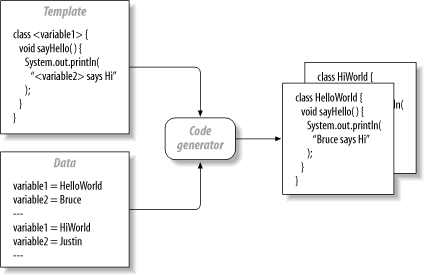|
|
< Day Day Up > |
|
4.6 Generating CodeAs you've probably noticed, many Java frameworks require a whole lot of tedious, redundant syntax. In his book Refactoring (Addison-Wesley), Martin Fowler calls such a design a "code smell." Since Java developers are a lazy and creative lot, they seek ways to automatically generate repeated bits of code. Further, they think of ingenious ways to configure their code generation engines. Take an EJB application, for example. In order to create the persistent model with a remote interface, you'll need to create at least seven files: the home object for lifecycle support, a local that serves as a proxy, the interface, implementation, primary key, deployment descriptor, and schema. With code generation tools like XDoclet, you can automatically generate at least five of the seven, and often six of the seven. You create an XDoclet by instrumenting your code with simple JavaDoc comments. While this technique doesn't make your code completely transparent with respect to persistence, it certainly makes it more transparent. 4.6.1 How Code Generation WorksWhile novice and intermediate Java developers see code generation as black magic, it's really quite simple. If you've ever used a mail merge program, you know how it works. You create a working piece of code. Then you mark the areas of the code that vary from instance to instance. Together, these form your template. Next, you provide data to fill in the variables. Like a mail merger, the code generator takes your template, fills in the blanks, and generates working code, as in Figure 4-7. Figure 4-7. Code generation works by combining a template with data Figure 4-7 shows the general concept, although it simplifies the problem in several ways. You can generate multiple targets. You can also generate code with complex structures, such as repeated or conditional blocks. In general, if you can describe the patterns in your code and clearly define areas of duplication, you can probably find or build something to generate it. There are several types of generation strategies:
As you can see, code generation lets you minimize redundant data through a variety of approaches. The end result is a happier developer who's not a slave to tedious details. 4.6.2 Code Generation and TransparencyYou can use code generation for much more than saving duplication. From a configuration file containing classes with properties and their types, you can generate a database schema, a transparent model, and a DAO layer. It's an interesting way to code, with several tangible benefits:
Whenever you read a list of benefits like this one, keep in mind that there's always a big "but." Generated code does have its downside:
String str = new String( );
Code generation is just one of the tools in your tool box and with each application, you should look at it with fresh skepticism. In particular, observe these rules:
As with the other techniques mentioned here, many readers of this book will never build a code generator. You don't have to. Instead, you can choose from a number of frameworks or products that enable code generation or use it under the covers. While code generation does not always provide transparency by itself, it can relieve you of many of the details when you're forced to use a framework that lacks transparency. |
|
|
< Day Day Up > |
|